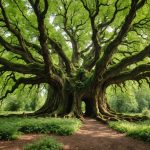Historical Context of Ancient Trees in the UK
The historical significance of ancient trees in the UK is deeply rooted in both the natural landscape and cultural heritage, becoming landmarks that whisper tales of bygone eras. These majestic trees have stood the test of time, playing pivotal roles in the culture and biodiversity of the region. They have not only shaped the physical environment but have also been woven into local myths, legends, and traditions, thereby enriching the cultural tapestry.
Ancient trees contribute significantly to local ecosystems, providing shelter and sustenance to myriad species, from fungi to birds, thereby enhancing biodiversity. Their ability to sequester carbon and regulate water cycles highlights their ecological importance, serving as fundamental components of the ecosystem.
Have you seen this : Exploring the Triumphs and Trials of Rewilding Initiatives Across the UK
Historically, conservation efforts for these natural giants have evolved significantly. Early initiatives often emerged from local communities and were later bolstered by formal organizations recognizing the trees’ biodiversity and cultural values. These efforts have gradually become more sophisticated, incorporating scientific research to better understand and preserve these natural relics. From ancient times until today, the UK’s tree heritage is a testament to ongoing efforts to marry ecological needs with cultural reverence.
Government Initiatives for Protecting Ancient Trees
In the UK, a robust framework of government policies supports the conservation of ancient trees, recognising their ecological and cultural value. Key initiatives include the Ancient Tree Inventory, a tool to catalog and monitor these invaluable natural assets. This project aids in shaping protective measures in land-use planning and conservation strategies.
Also read : Top Strategies for UK Residents to Reduce Bird-Glass Collisions in Skyscrapers
The Woodland Policy, established by various government bodies, outlines regulations that promote sustainable management and preservation of ancient woodlands. It encourages local authorities and landowners to implement tailored conservation plans that safeguard these trees from threats such as urban sprawl and pollution.
Successful examples of government-led initiatives reveal the impact of robust policies on tree protection. For instance, collaboration with Scottish Forestry has ensured protective status for several ancient trees across national sites, reflecting a commitment to proactive conservation.
To effectuate these strategies, laws like the Forestry Act regulate activities around woodlands, serving as a legal backbone. These initiatives demonstrate a concerted effort by the government to protect ancient tree heritage, ensuring these natural landmarks continue to thrive for future generations.
Non-Profit Organizations and Community Efforts
In the realm of ancient tree conservation, non-profit organizations have positioned themselves as influential agents of change. These organizations have diligently worked to bridge gaps between scientific research and practical conservation, fostering a greater awareness of the importance of protecting these natural landmarks.
Community-driven initiatives play a significant role in bolstering conservation efforts. Local groups often take the lead in organising volunteer initiatives that focus on planting native tree species, monitoring the health of existing trees, and educating the public on the ecological and cultural value of ancient trees. Such grassroots movements not only augment conservation goals but also imbue communities with a sense of belonging and stewardship.
Collaboration between NGOs and the government enhances these efforts through resource pooling and shared expertise. Government bodies often provide funding and strategic direction, while non-profits offer on-the-ground implementation and community mobilisation.
This symbiotic relationship has led to the successful conservation of numerous ancient trees, establishing practices that are both resilient and adaptable. Their combined expertise ensures that community tree projects remain proactive in addressing the complexities of conserving the UK’s arboreal heritage.
Ecological Importance of Ancient Trees
Ancient trees are the pillars of local ecosystems, offering vast ecological benefits that underscore their pivotal role in biodiversity. These venerable giants provide vital ecosystem services such as carbon storage, soil stabilization, and water regulation. As they stand through centuries, ancient trees sequester considerable carbon amounts, mitigating climate change by reducing atmospheric carbon dioxide. Their massive canopies intercept rainwater, aiding in water retention and runoff reduction, crucial in flood prevention.
Furthermore, ancient trees foster a vibrant coexistence with various species. Their extensive root systems create habitats for fungi, enriching soil with nutrients. Birds, insects, and mammals find refuge in their branches and hollows, exemplifying the tree’s role as a cornerstone in complex food webs. This interdependence nurtures a diverse array of life, creating biological corridors that sustain thriving ecosystems.
In essence, ancient trees act as timekeepers of nature, their ecological roles integral to ecosystem health and resilience. By understanding their contributions, we can better appreciate their indispensable value, reinforcing efforts to protect and preserve these formidable fixtures of our natural environment.
Recent Developments in Conservation Practices
The evolution of modern conservation techniques for ancient trees has been notably transformative. Recent advancements in conservation practices highlight a shift towards more scientific and innovative strategies. Notably, research into environmental DNA (eDNA) has been groundbreaking, deepening our understanding of tree health and longevity.
Emerging technologies like drones and AI-driven models are significantly altering the conservation landscape. Drones offer unprecedented access to tree canopies, allowing for the monitoring of tree conditions without disturbing their natural habitats. Meanwhile, AI helps in analysing vast datasets, predicting tree health trends, and identifying endangered species promptly.
Research advancements also provide insights into biodiversity patterns and climate resilience. Projects focusing on genetic diversity ensure that ancient trees can withstand environmental stresses and disease. Scholars are now prioritizing studies that reveal how ancient trees maintain ecosystem balance over centuries.
These innovative strategies pave the way for more robust and comprehensive conservation efforts. By incorporating technology and contemporary scientific methods, conservation practices are not only more efficient but also ensure that ancient trees remain integral parts of our natural heritage, contributing to both ecological stability and cultural significance.
Cultural Heritage and Community Engagement
At the heart of community involvement in ancient tree conservation is the recognition of their profound cultural heritage. These trees are not merely components of landscapes but serve as living links to history. They embody local identities and traditions, often inspiring stories passed down through generations. This historical resonance makes them crucial in understanding both local heritage and a broader narrative of the region.
Engaging communities in conservation is paramount. Effective strategies include public awareness campaigns, which educate on the values of these natural monuments and rally local support for their protection. These initiatives promote local participation by creating engaging events, workshops, and educational programs focusing on ancient trees.
Several successful heritage campaigns vividly demonstrate how community voices can safeguard tree heritage. In areas like Sussex, local efforts have led to the preservation of iconic trees under threat from development. Such campaigns often combine storytelling with advocacy, spotlighting trees as treasures of local culture. These grassroots movements highlight the power of collective action in ensuring that ancient trees continue to stand as potent symbols of shared history and community identity.
Challenges in Protecting Ancient Trees
Ancient trees in the UK face a myriad of challenges that threaten their longevity and ecological roles. Prominent threats to ancient trees include urban development, which encroaches on natural landscapes, fragmenting habitats essential for tree preservation. As cities expand, these venerable trees often stand in the way of infrastructure projects, creating conflicts between development initiatives and conservation goals.
Environmental pressures also play a significant role in the threats faced by ancient trees. Climate change accelerates issues like altered rainfall patterns and temperature fluctuations, impacting tree health and resilience. The increase in severe weather events can lead to physical damage, while shifts in ecosystems can disrupt the complex interdependencies that sustain these trees and their associated species.
Moreover, ancient trees face pressures from pollution, particularly air and soil contaminants, which weaken their structural integrity and ecological functions. These challenges require nuanced conservation approaches that balance human needs with ecological sustainability. Understanding these pressures is crucial for developing strategies to mitigate their impact, ensuring that conservation efforts address both immediate and long-term threats efficiently. Through comprehensive policies, increased awareness, and dedicated action, the protection of ancient trees can be achievable against these daunting challenges.
Future Directions for Ancient Tree Conservation
Future conservation strategies for ancient trees envision a balance between preservation and societal progress. Ensuring the longevity of these invaluable natural assets requires innovative and sustainable practices that harmonise ecological needs with developmental pressures. Crafting policies that integrate conservation with land-use planning, particularly in urban areas, is fundamental. Such policies can help navigate conflicts arising from land scarcity, protecting ancient trees from encroachment while still allowing for necessary societal development.
One promising approach is enhancing long-term preservation efforts through genetic research. Understanding genetic resilience can guide the planting and nurturing of new tree generations, reinforcing ancient trees’ ecological contributions. This involves fostering diverse and resilient tree populations that can withstand future environmental stresses.
Education and advocacy play pivotal roles in ensuring sustained success. Raising public awareness about ancient trees’ ecological and cultural significance galvanises community involvement. Advocacy-driven initiatives can lead to the formulation of protective legislation and garner widespread support for conservation goals. By nurturing a culture of environmental stewardship, future conservation strategies will be more inclusive and community-oriented. This unified effort ensures that ancient trees remain a living testament to both our natural and cultural heritage for generations to come.











